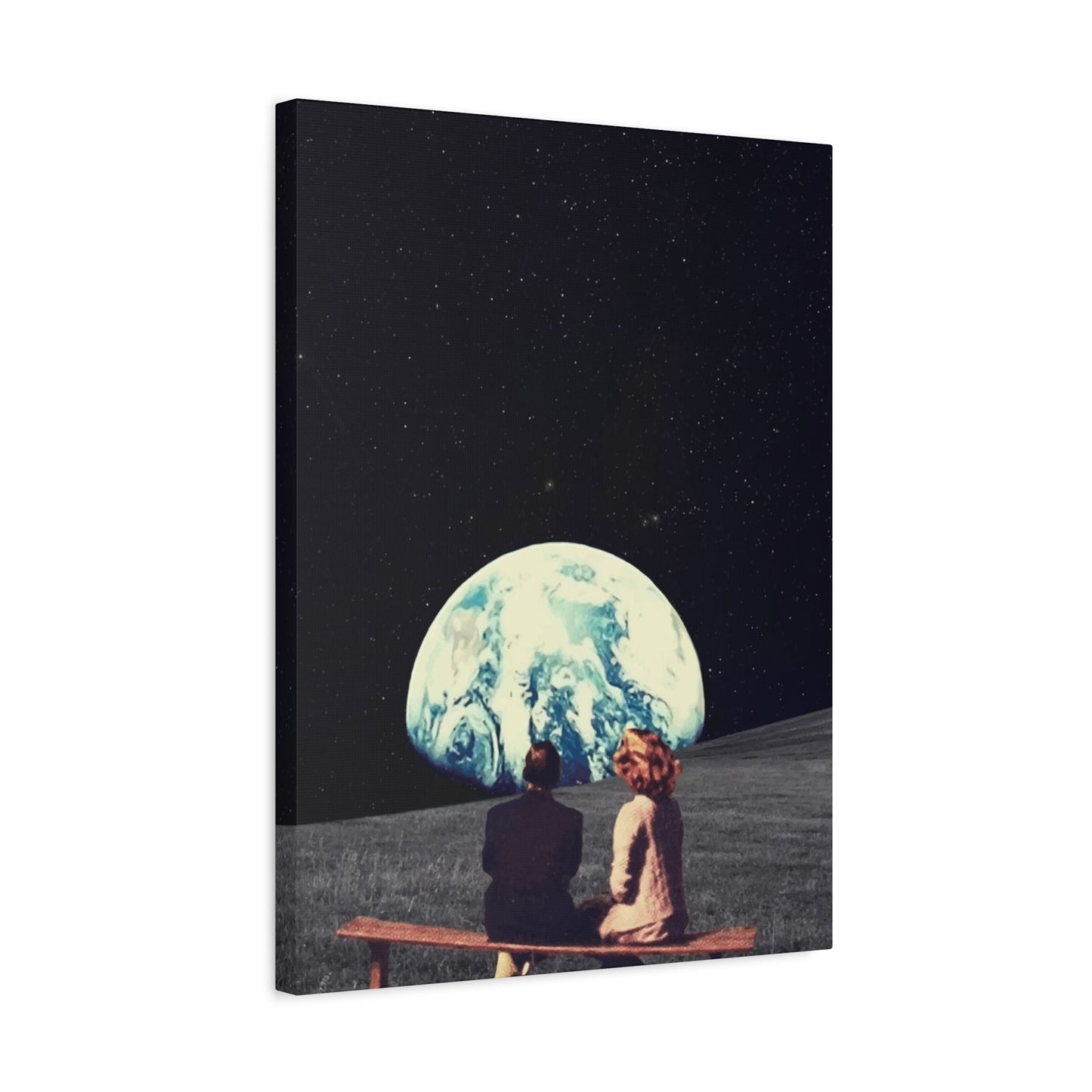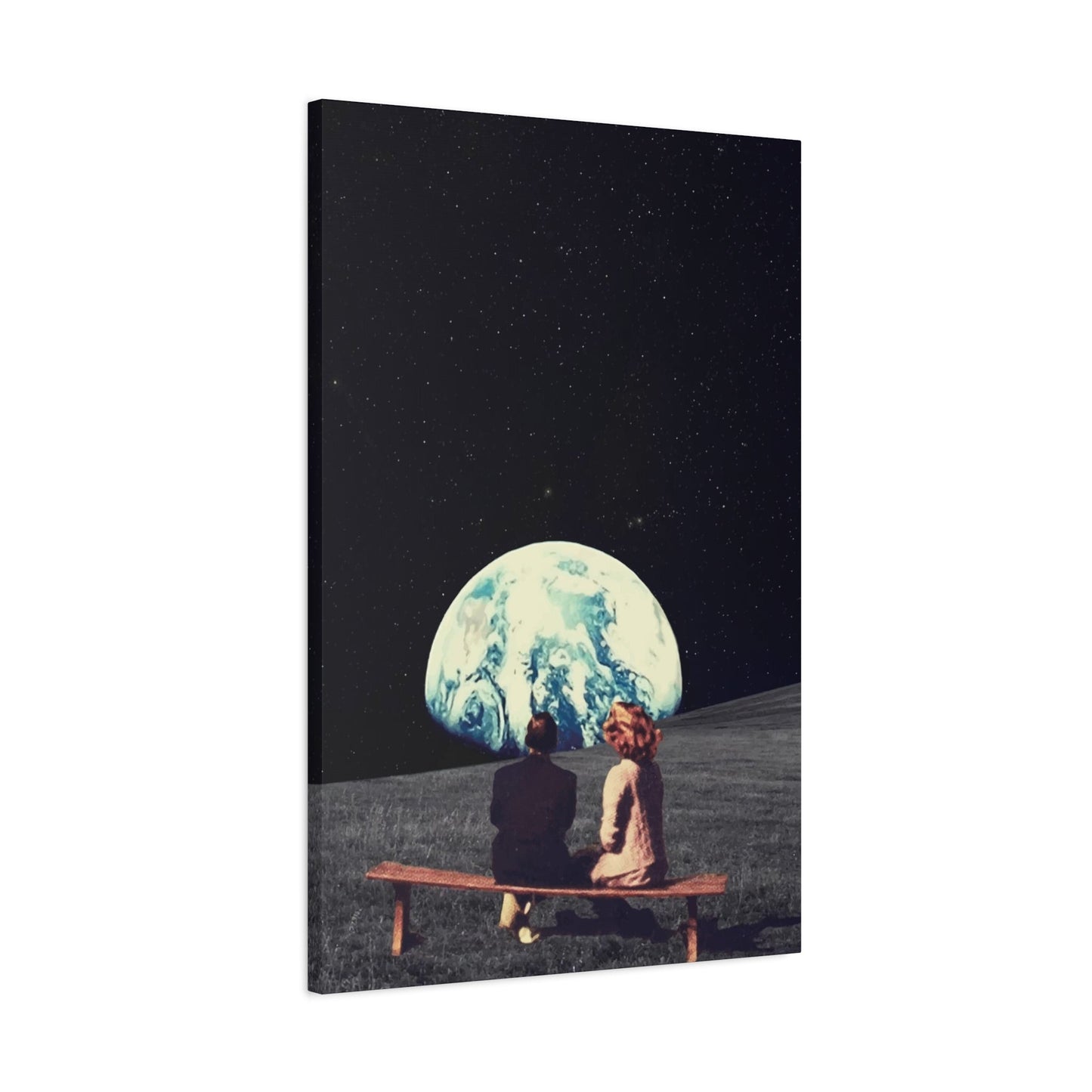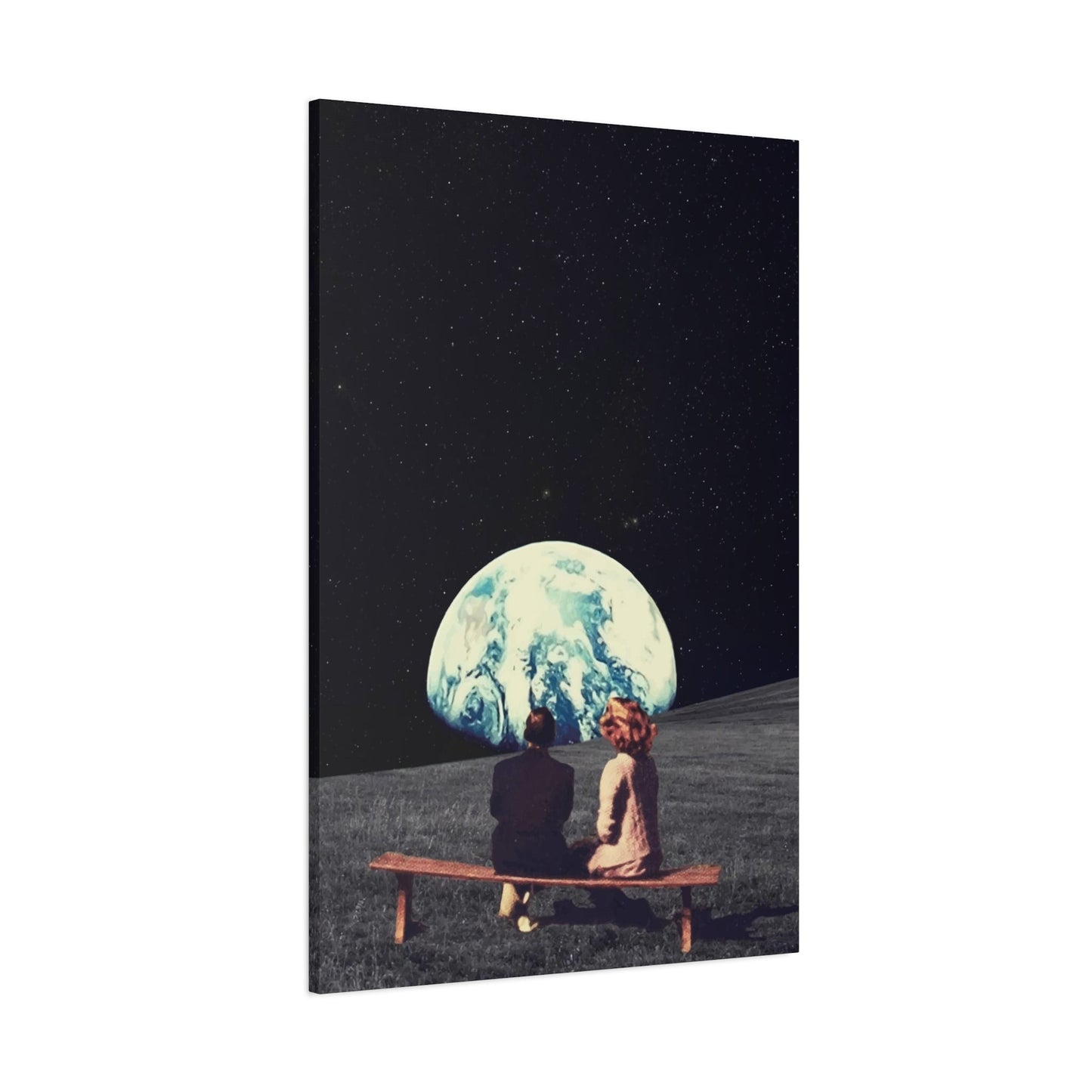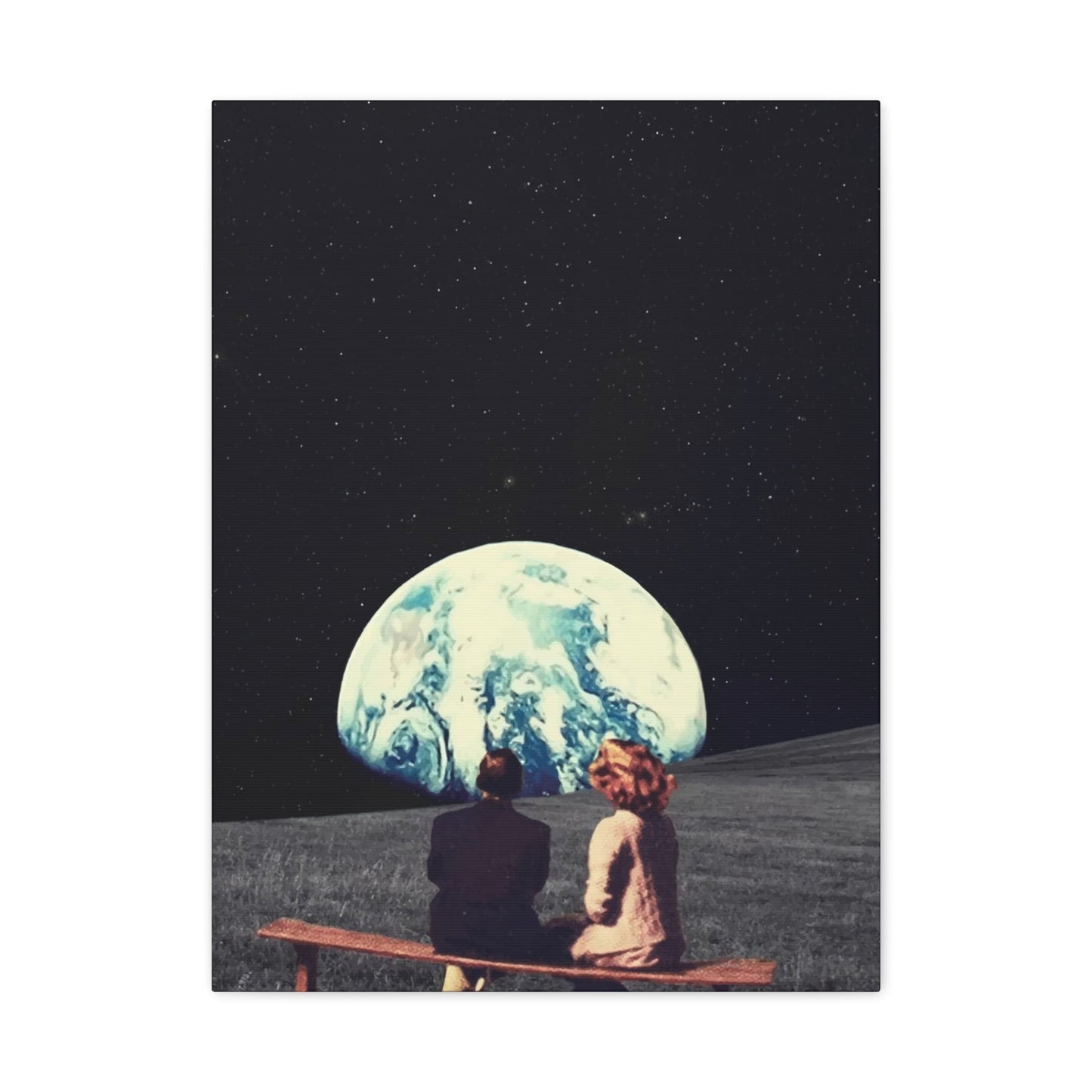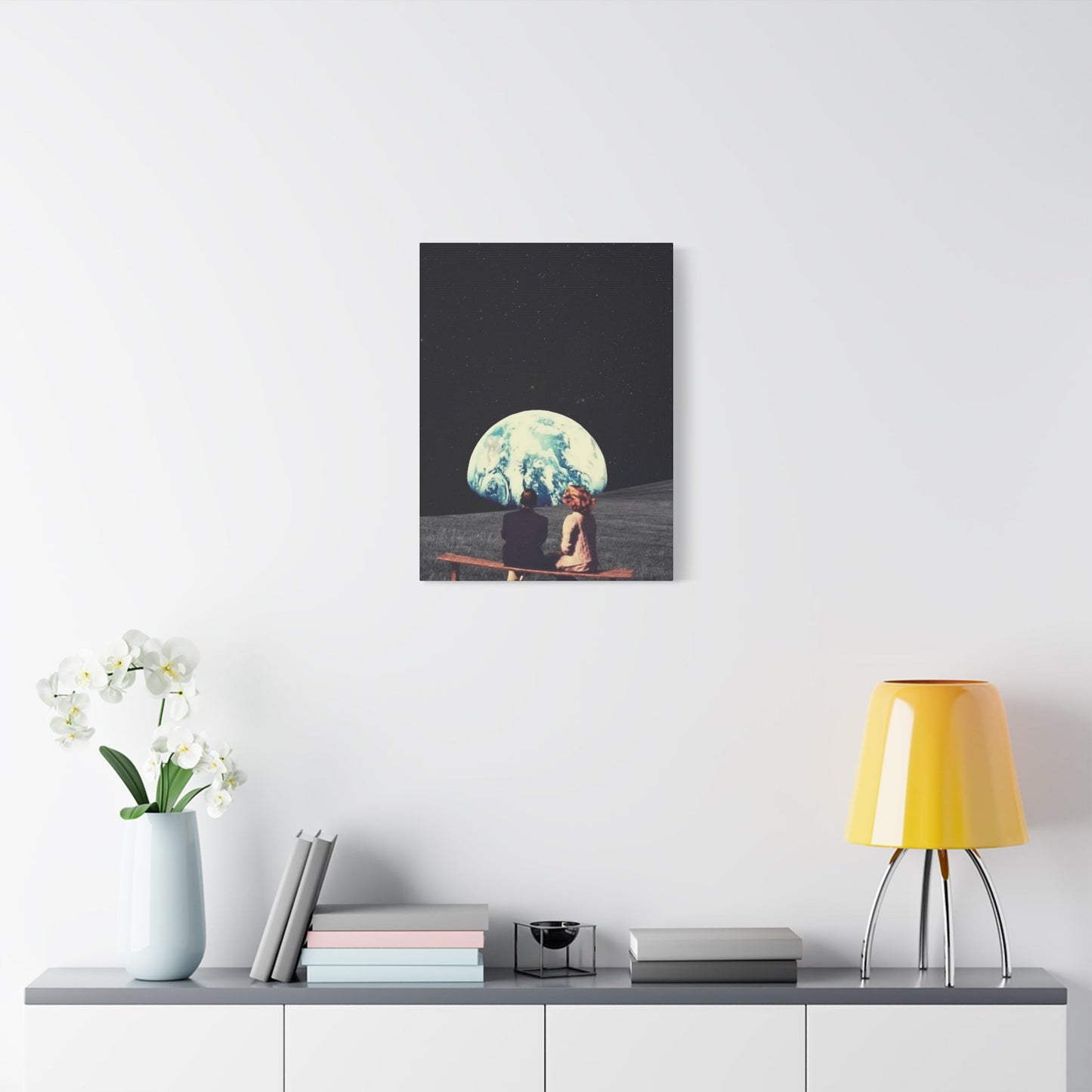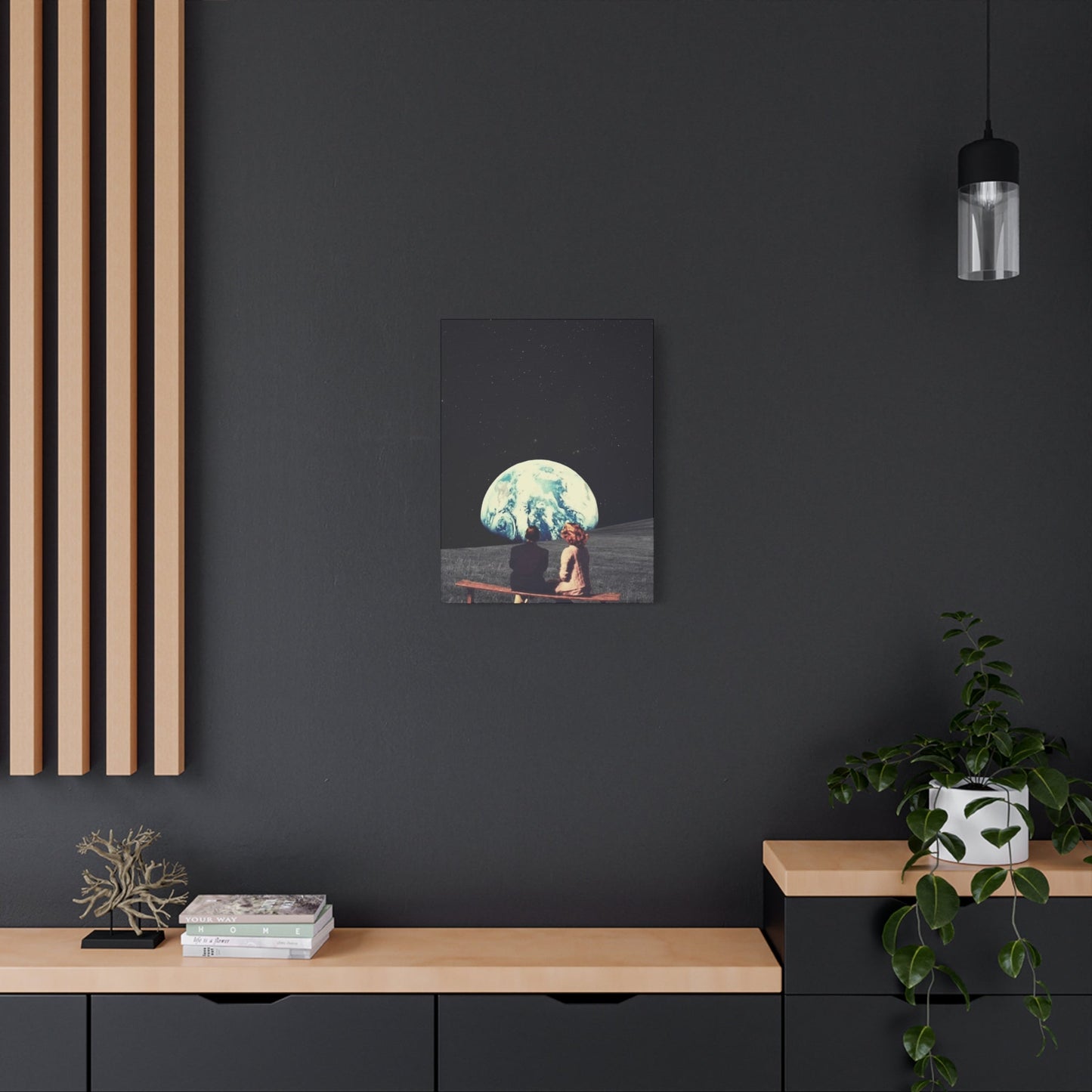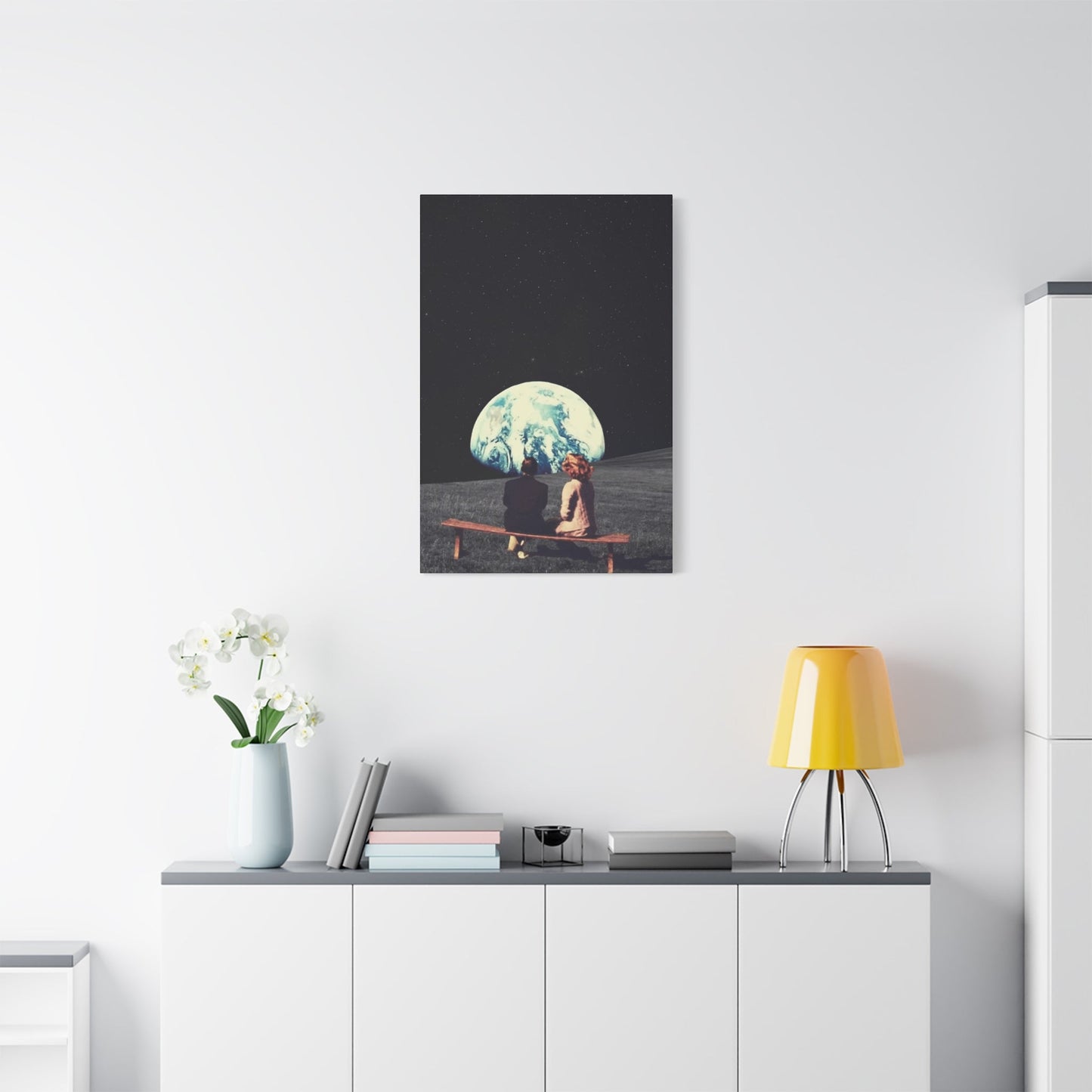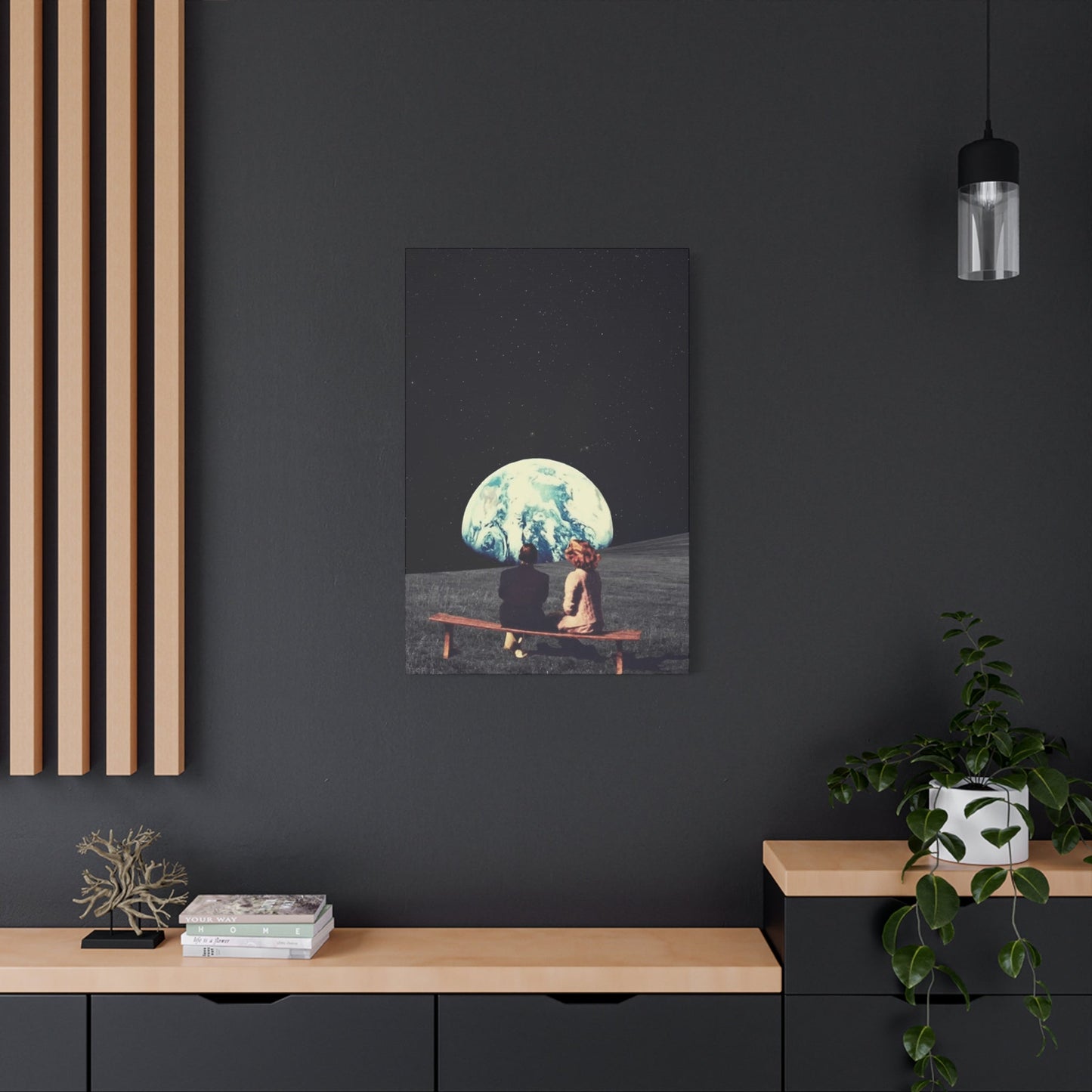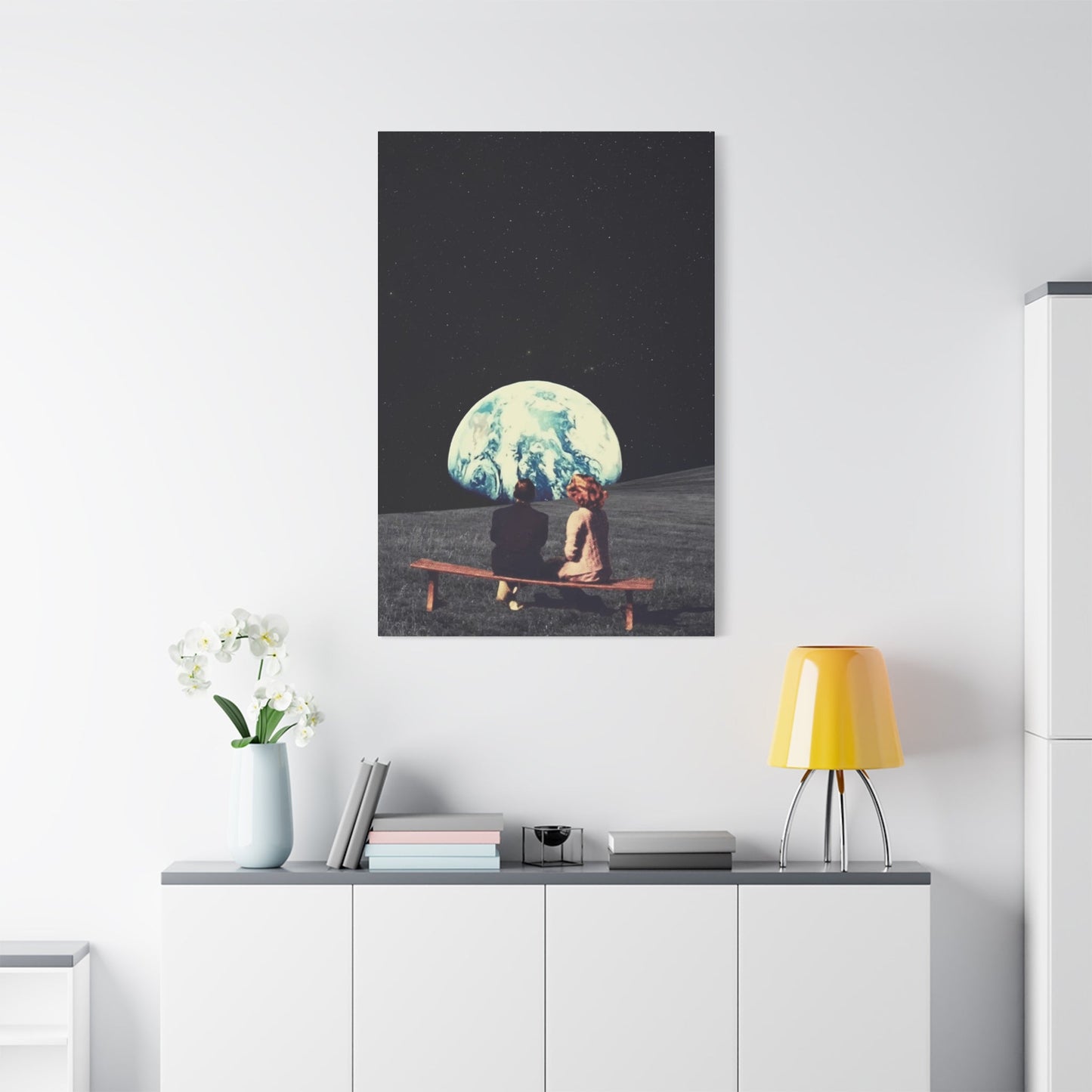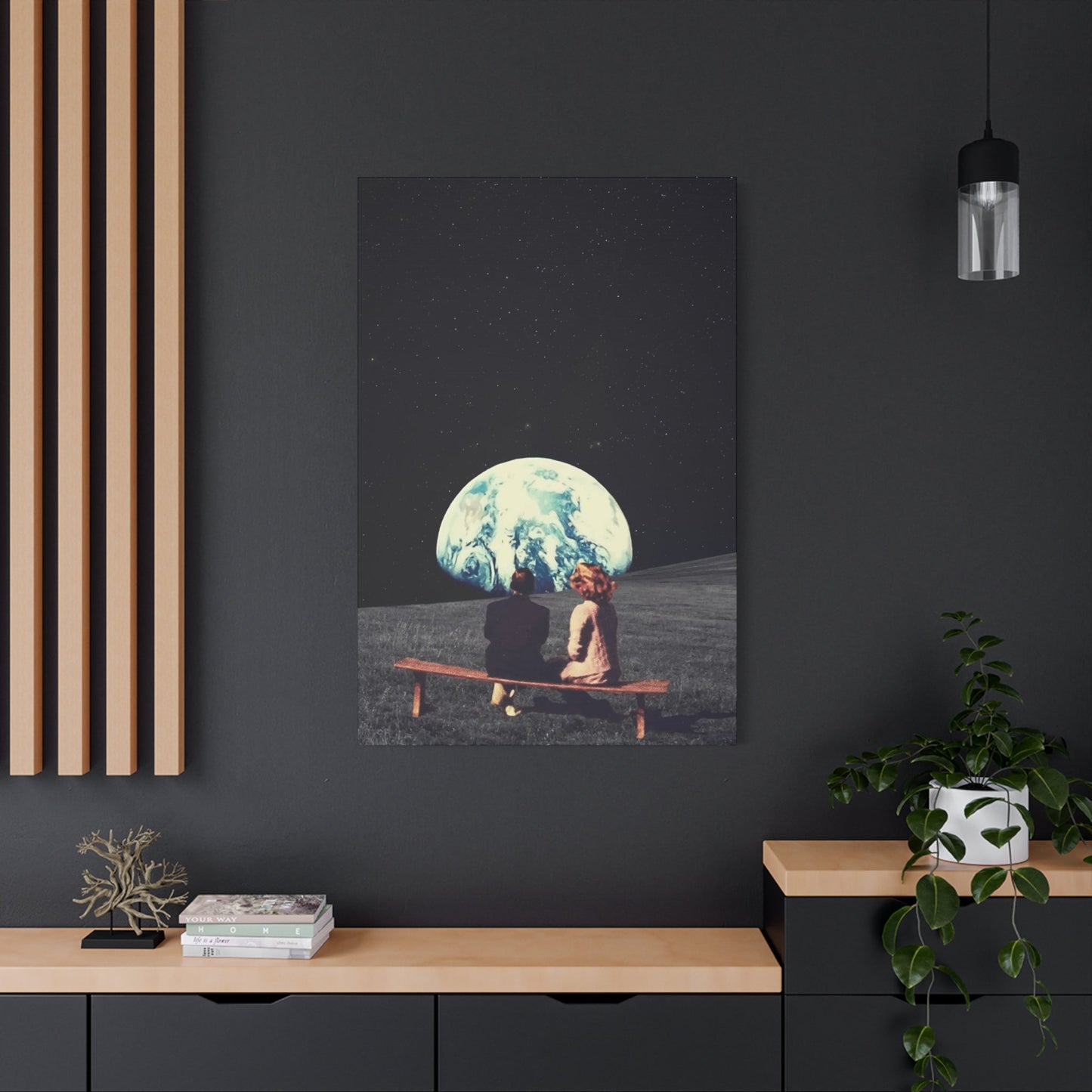Modern Living Meets Cosmic Wonder with Earthrise Moon Wall Art
The breathtaking vision of our blue marble suspended above the barren lunar surface has captivated humanity since the first astronauts witnessed this extraordinary sight. This celestial perspective has evolved beyond its scientific origins to become a compelling artistic medium that transforms residential environments into cosmic sanctuaries. The powerful imagery of our planet rising above the Moon's horizon creates an emotional connection that resonates deeply with viewers, offering both aesthetic pleasure and philosophical contemplation.
The artistic interpretation of this cosmic phenomenon provides homeowners with a unique opportunity to bring the majesty of the universe into their living environments. The contrast between Earth's vibrant blues and swirling white clouds against the stark, cratered lunar landscape creates a visual narrative that speaks to the human spirit's desire for exploration and wonder. This imagery serves as a constant reminder of our planet's beauty, fragility, and unique position in the cosmos.
The growing popularity of astronomical themes in contemporary home decoration reflects society's increasing awareness of our place in the universe and our connection to the cosmos. Homeowners are drawn to artwork that provides meaning beyond mere decoration, seeking pieces that inspire contemplation, spark conversation, and create emotional connections. The earthrise perspective offers all these qualities while maintaining universal appeal and timeless relevance.
The emotional impact of viewing our planet from this extraordinary vantage point cannot be understated. Astronauts who have experienced this view firsthand describe it as profoundly transformative, leading to a deeper appreciation for Earth's interconnected systems and the unity of all life. Artwork depicting this perspective allows earthbound viewers to experience a similar sense of awe and connection to the larger universe.
The versatility of earthrise imagery makes it suitable for various decorative styles and personal preferences. Whether rendered as photorealistic reproductions, artistic interpretations, or abstract representations, these images maintain their emotional power while adapting to different aesthetic contexts. The natural color palette of blues, whites, and grays provides a sophisticated foundation that complements numerous decorative schemes.
The scientific accuracy inherent in many earthrise artworks adds an educational dimension that appeals to those interested in astronomy, geology, and environmental science. The detailed representation of lunar surface features, accurate positioning of celestial bodies, and realistic lighting conditions contribute to the authenticity that makes these pieces particularly compelling. This combination of scientific precision and artistic beauty creates multi-dimensional artwork that serves both decorative and educational purposes.
The cultural significance of the earthrise perspective extends far beyond aesthetic considerations. These images have become powerful symbols of environmental awareness, global unity, and humanity's shared responsibility for protecting our planet. The overview effect experienced by space travelers has led to increased environmental consciousness and a deeper understanding of Earth's interconnected systems. Artwork depicting this cosmic perspective helps bring these important messages into everyday living environments.
Historical Significance and Cultural Impact of Lunar Photography
The moment when humans first witnessed and captured Earth rising above the lunar horizon marked a pivotal point in human consciousness and artistic expression. The famous Apollo 8 mission photographs from December 1968 not only documented a scientific achievement but also created some of the most influential images in human history. These photographs fundamentally altered humanity's perception of Earth, transforming it from an infinite, unchanging backdrop to a finite, precious oasis in the vast darkness of the universe.
The cultural impact of these lunar photographs extends far beyond their immediate scientific value. They arrived during a turbulent period in human history, providing a perspective that transcended political boundaries, racial divisions, and national conflicts. The image of Earth as a unified, borderless sphere floating in the cosmic void became a powerful symbol for the environmental movement, peace activism, and global consciousness that emerged in the following decades.
The artistic community quickly embraced these images as inspiration for countless works across various media. Painters, sculptors, photographers, and digital artists have drawn upon the emotional power and visual drama of the earthrise perspective to create works that explore themes of isolation, beauty, fragility, and cosmic significance. The influence of these images can be seen in everything from large-scale public installations to intimate personal artwork.
The technological achievement represented by these photographs also carries significant cultural weight. They document humanity's first steps beyond Earth, representing our species' drive to explore, discover, and push beyond established boundaries. This aspect of the imagery appeals to those who celebrate human innovation, scientific achievement, and the spirit of exploration that defines our species.
The environmental movement found particular inspiration in these cosmic perspectives. The sight of Earth as a small, isolated sphere surrounded by infinite darkness emphasized the planet's vulnerability and the need for careful stewardship of its resources. Environmental activists and scientists have used these images to illustrate the interconnectedness of Earth's systems and the importance of protecting our planetary home.
The philosophical implications of viewing Earth from lunar distance have influenced religious and spiritual thinking across cultures. The perspective challenges anthropocentric worldviews and encourages a more cosmic understanding of humanity's place in the universe. Many spiritual traditions have incorporated these images into their teachings about interconnectedness, unity, and the sacred nature of our planetary home.
The democratization of these images through reproduction and artistic interpretation has allowed people worldwide to experience something approximating the transformative perspective that astronauts describe. While not equivalent to the direct experience, artistic representations of the earthrise phenomenon provide accessible means for individuals to connect with this cosmic perspective and its associated insights.
The evolution of earthrise imagery from scientific documentation to artistic inspiration demonstrates the power of certain images to transcend their original context and become universal symbols. These photographs have achieved iconic status comparable to the greatest works of art, inspiring contemplation, discussion, and emotional response across cultural and generational boundaries.
Psychological Benefits of Cosmic Artwork in Living Environments
The incorporation of earthrise imagery into residential environments provides numerous psychological benefits that extend beyond mere aesthetic enhancement. Research in environmental psychology suggests that artwork depicting natural scenes, particularly those showing expansive vistas, can reduce stress, improve mood, and enhance cognitive function. The cosmic perspective offered by earthrise imagery amplifies these benefits by providing an even more expansive view that encompasses the entire planet.
The meditative quality of gazing upon Earth from lunar distance creates opportunities for reflection and contemplation that are increasingly valuable in our fast-paced, technology-driven world. The serene beauty of the image, combined with its profound implications for human perspective, encourages viewers to pause, reflect, and consider their place in the larger cosmos. This contemplative aspect can serve as a form of visual meditation that promotes mental well-being and stress reduction.
The sense of perspective provided by cosmic imagery can be particularly beneficial for individuals dealing with anxiety, depression, or overwhelming life circumstances. Viewing Earth from the ultimate wide-angle perspective can help put personal problems into cosmic context, providing relief from the tendency to become overwhelmed by immediate concerns. This shift in perspective often leads to increased resilience and a greater ability to cope with life's challenges.
The inspirational quality of earthrise imagery can stimulate creativity and encourage innovative thinking. The extraordinary nature of the cosmic perspective challenges conventional ways of seeing and understanding the world, potentially opening new avenues of thought and creative expression. Many artists, writers, and innovators report that exposure to cosmic imagery helps them think beyond conventional boundaries and explore new possibilities.
The connection to scientific achievement and human exploration embodied in earthrise imagery can provide motivational benefits for viewers. The reminder of humanity's capacity for extraordinary achievement can inspire personal goal-setting and encourage persistence in the face of challenges. The images serve as tangible proof that seemingly impossible dreams can be realized through dedication, creativity, and collaborative effort.
The biophilic response to viewing Earth from the cosmic perspective can strengthen the connection between indoor environments and the natural world. Even though the view is from extreme distance, the recognition of Earth as our planetary home can satisfy some of the psychological needs typically met through direct contact with nature. This connection is particularly valuable for urban dwellers who may have limited access to natural environments.
The educational aspects of cosmic imagery can provide cognitive stimulation that contributes to mental well-being. Learning about astronomical phenomena, space exploration, and Earth's unique characteristics engages the mind in positive ways that can improve cognitive function and provide a sense of intellectual accomplishment. The combination of visual beauty and educational content creates rich, multi-layered experiences that engage multiple aspects of human psychology.
The social benefits of displaying cosmic artwork should not be overlooked. These images serve as conversation starters that can lead to meaningful discussions about science, philosophy, environmentalism, and humanity's future. The shared experience of contemplating our cosmic perspective can strengthen relationships and create connections between individuals who might otherwise have little in common.
Contemporary Design Trends Incorporating Astronomical Themes
Modern home design increasingly embraces astronomical themes as homeowners seek to create environments that reflect their interests in science, exploration, and cosmic wonder. The integration of earthrise imagery fits perfectly within this trend, offering sophisticated artwork that appeals to contemporary sensibilities while providing the depth and meaning that today's homeowners desire. The clean lines, dramatic contrasts, and natural color palettes characteristic of cosmic imagery align seamlessly with current design preferences.
The minimalist movement has found particular resonance with astronomical themes, as the vast emptiness of the universe mirrors the uncluttered aesthetic that defines minimalist design. Earthrise imagery provides the perfect focal point for minimalist rooms, offering visual interest and emotional depth without overwhelming the carefully balanced compositions that characterize this style. The essential simplicity of Earth suspended in the cosmic void embodies minimalist principles while providing the kind of meaningful content that elevates mere simplicity to profound elegance.
Scandinavian design principles, with their emphasis on natural beauty, functional simplicity, and connection to the environment, find natural harmony with cosmic themes. The cool color palettes, clean lines, and emphasis on light that characterize Nordic design complement the visual characteristics of earthrise imagery. The environmental consciousness that underlies much Scandinavian design philosophy aligns perfectly with the ecological awareness that cosmic perspectives often inspire.
Industrial and loft-style environments benefit significantly from the technological associations of lunar photography. The celebration of human achievement, mechanical precision, and innovative thinking that characterizes industrial design finds perfect expression in images that document humanity's greatest technological accomplishments. The scale and drama of cosmic imagery can effectively fill the large wall areas common in industrial environments while complementing exposed architectural elements.
The biophilic design movement, which emphasizes connections to the natural world, has discovered unexpected applications in cosmic imagery. While these images show Earth from an extreme distance, they simultaneously represent the ultimate expression of natural beauty and the interconnectedness of all life. The global perspective can satisfy biophilic needs while introducing a scale of natural appreciation that encompasses the entire biosphere.
Smart home integration offers exciting possibilities for displaying and enhancing cosmic artwork. Digital display systems can rotate through various earthrise images, providing dynamic visual experiences that change throughout the day or respond to the viewer's preferences. Smart lighting systems can adjust color temperature and intensity to complement the cosmic theme, creating immersive environments that enhance the emotional impact of the artwork.
The growing emphasis on sustainable design practices creates meaningful connections between cosmic artwork and environmental values. The overview effect associated with viewing Earth from the cosmic perspective often leads to increased environmental awareness and commitment to sustainable living practices. Homeowners who display such imagery often extend these values to their material choices, energy usage, and overall approach to sustainable living.
Contemporary color trends increasingly favor the sophisticated blues, grays, and whites that characterize earthrise imagery. These colors provide excellent foundations for contemporary decorating schemes while offering the psychological benefits associated with cool, calming hues. The natural origin of these colors gives them an authentic quality that resonates with contemporary preferences for genuine, meaningful design elements.
Optimal Placement Strategies for Maximum Visual Impact
The strategic positioning of earthrise artwork within residential environments requires careful consideration of viewing angles, lighting conditions, and surrounding elements to achieve maximum visual and emotional impact. The dramatic nature of cosmic imagery demands placement that allows for proper viewing distance and unobstructed sightlines while complementing the overall room composition and functionality.
The ideal viewing distance for earthrise artwork depends on the size and detail level of the piece. Larger works benefit from placement that allows viewers to step back and appreciate the full composition, while smaller pieces may be positioned for more intimate viewing experiences. The goal is to recreate something approximating the experience of actually witnessing the earthrise phenomenon, which requires sufficient distance to appreciate the scale and relationship between celestial bodies.
Lighting considerations play a crucial role in maximizing the impact of cosmic artwork. Natural lighting can enhance the authenticity of the cosmic perspective, particularly when the artwork is positioned to receive indirect daylight that mimics the lighting conditions visible in lunar photography. However, artificial lighting systems offer greater control over the viewing experience and can be adjusted to complement the specific characteristics of the artwork.
The height at which cosmic artwork is positioned significantly affects the viewing experience. Placement at eye level when seated encourages contemplative viewing, while slightly higher positioning can create a sense of looking up into the cosmos. The chosen height should consider the primary activities that occur in the room and the typical viewing positions of the intended audience.
The relationship between earthrise artwork and surrounding furnishings requires careful consideration to avoid visual competition or distraction. Simple, clean backgrounds allow the dramatic contrasts of cosmic imagery to take center stage, while busy or colorful surroundings can diminish the impact. The goal is to create a visual environment that supports and enhances the cosmic perspective rather than competing with it.
Corner placement can be particularly effective for earthrise artwork, as it allows the image to serve as a focal point that draws the eye into the room while providing adequate viewing distance from multiple angles. Corner positioning also takes advantage of natural lighting patterns and can help define seating arrangements that optimize viewing experiences.
The consideration of traffic patterns within the room affects both the practical and aesthetic aspects of artwork placement. Positioning that allows for natural pause points in movement through the room can encourage spontaneous contemplation and appreciation. However, placement should avoid areas where the artwork might be damaged by passing traffic or where viewers might obstruct others' ability to appreciate the piece.
Multiple piece arrangements can create powerful cosmic narratives when earthrise imagery is combined with other astronomical artwork. Sequential arrangements that show different phases of Earth's appearance from lunar perspective can create dynamic visual stories that engage viewers over extended periods. However, such arrangements require careful attention to spacing, scale relationships, and thematic coherence.
The acoustic environment surrounding cosmic artwork placement should not be overlooked. Quiet areas that encourage contemplation and reflection enhance the meditative aspects of cosmic imagery, while positioning near sound sources may diminish the peaceful, contemplative experience that these images naturally inspire. The goal is to create environments that support both visual appreciation and emotional connection.
Color Harmony and Coordination with Existing Décor
The natural color palette present in earthrise imagery provides an excellent foundation for creating harmonious decorative schemes that feel both sophisticated and emotionally resonant. The dominant blues representing Earth's oceans and atmosphere offer versatility that complements numerous existing color schemes while providing opportunities for both subtle coordination and bold accent strategies. Understanding how to work with these natural cosmic colors enables homeowners to integrate earthrise artwork seamlessly into their existing décor.
The blues present in Earth imagery range from deep navy representing ocean depths to lighter azure reflecting atmospheric scattering, providing a comprehensive palette that can serve various decorative functions. These natural blues work exceptionally well as primary colors in coastal, nautical, and contemporary schemes while serving as sophisticated accent colors in more neutral environments. The organic origin of these colors gives them an authenticity that resonates with current preferences for natural, meaningful design elements.
Complementary color relationships offer powerful tools for enhancing the visual impact of earthrise artwork. The cool blues dominant in cosmic imagery find natural complements in warm oranges, corals, and amber tones that can be introduced through lighting, textiles, or accent pieces. These warm complements can add energy and vitality to rooms while maintaining the cosmic theme and creating dynamic visual interest.
Analogous color schemes using variations of blue and gray create sophisticated, calming environments that emphasize the serene aspects of the cosmic perspective. This approach works particularly well in bedrooms, meditation areas, and professional environments where tranquility and focus are desired. The subtle variations in tone and intensity within the analogous palette prevent monotony while maintaining visual cohesion and supporting the contemplative nature of cosmic imagery.
Neutral foundations provide excellent support for earthrise artwork, allowing the natural drama of the cosmic imagery to take center stage without competing visual elements. Warm whites, soft grays, and subtle beiges create clean backdrops that emphasize the inherent contrasts in lunar photography while providing flexibility for seasonal changes or the addition of other decorative elements over time.
Metallic elements, particularly silver and platinum tones, can enhance the technological and scientific aspects of cosmic themes while adding visual interest and luxury to the overall composition. These metallic elements might appear in frame selections, lighting fixtures, or decorative objects that complement the primary artwork. The reflective qualities of metallic elements help distribute light throughout the room while reinforcing the high-tech associations of lunar exploration.
The consideration of color temperature in both natural and artificial lighting becomes particularly important when working with cosmic-themed artwork. Cool white lighting reminiscent of starlight and lunar illumination can enhance the authenticity of the cosmic theme while providing excellent color rendering for the blues and grays in the artwork. Strategic use of warmer lighting can create intimate, contemplative atmospheres that encourage prolonged viewing and reflection.
Seasonal color adaptations allow cosmic-themed rooms to maintain their core identity while incorporating fresh elements throughout the year. Spring might introduce subtle green accents representing Earth's vegetation, while autumn could incorporate warm earth tones that complement the cosmic blues. Winter naturally aligns with the cool cosmic palette, while summer might emphasize the brighter blues and whites present in the imagery.
The psychological effects of color combinations should inform decisions about coordinating cosmic artwork with existing décor. The calming effects of blues promote relaxation and contemplation, while the addition of complementary colors can provide energy and stimulation. Balancing these effects according to the room's intended function creates environments that support desired activities and emotional states.
Lighting Techniques to Enhance Cosmic Photography
Proper illumination plays a crucial role in maximizing the visual impact and emotional resonance of earthrise artwork, as lighting can either enhance or diminish the dramatic contrasts and subtle details that make these images so compelling. The unique characteristics of cosmic photography, with its extreme contrasts between bright Earth and dark lunar landscape, require thoughtful lighting approaches that preserve these essential qualities while integrating harmoniously with the overall room environment.
Natural lighting offers the most authentic illumination for cosmic artwork, as daylight shares many characteristics with the lighting conditions visible in actual lunar photography. Positioning earthrise images to receive indirect natural light can enhance their realism while providing the kind of even, diffused illumination that reveals subtle details without creating harsh reflections or glare. However, direct sunlight should be avoided to prevent damage to the artwork and to maintain the subtle tonal relationships that characterize cosmic imagery.
Track lighting systems provide excellent flexibility for illuminating cosmic artwork, allowing for precise control over beam angle, intensity, and positioning. The ability to adjust individual fixtures enables highlighting of specific areas within the artwork while maintaining appropriate illumination levels for the surrounding environment. Track systems also accommodate changes in artwork positioning or the addition of multiple pieces without requiring electrical modifications.
LED lighting technology offers particular advantages for illuminating cosmic artwork due to its color accuracy, energy efficiency, and longevity. Full-spectrum LED systems can provide color rendering that accurately reproduces the subtle blues and grays present in earthrise imagery while offering dimming capabilities that allow adjustment for different viewing conditions and times of day. The minimal heat generation of LED systems also helps protect artwork from thermal damage.
Accent lighting can be used to create dramatic effects that enhance the cosmic theme while drawing attention to the artwork. Subtle uplighting can create the suggestion of starlight or lunar illumination, while carefully positioned spotlights can emphasize the three-dimensional qualities of framed artwork. However, accent lighting should be used judiciously to avoid overwhelming the inherent drama of the cosmic imagery.
The color temperature of lighting significantly affects the appearance and emotional impact of earthrise artwork. Cool white lighting (4000-5000K) enhances the authentic appearance of cosmic imagery while providing excellent color rendering for blues and grays. However, warmer lighting (2700-3000K) can create more intimate, contemplative atmospheres that encourage prolonged viewing and reflection. Many installations benefit from lighting systems that allow adjustment between different color temperatures.
Dimming capabilities provide essential flexibility for optimizing the viewing experience of cosmic artwork under different conditions. Full illumination may be appropriate for detailed study of the artwork, while reduced lighting levels can create more meditative, contemplative atmospheres. The ability to adjust lighting intensity also allows accommodation of different activities within the room without compromising the artwork's visual impact.
Glare control becomes particularly important when illuminating cosmic artwork due to the reflective properties of many framing and mounting materials. Non-reflective glass or acrylic glazing can minimize reflections, while careful attention to lighting angle and intensity prevents glare that could interfere with viewing. The goal is to provide adequate illumination without creating reflections that compete with the artwork for the viewer's attention.
Integrated lighting solutions, such as illuminated frames or backlighting systems, offer innovative approaches to enhancing cosmic artwork. These systems can provide even, shadowless illumination that enhances the artwork's details while creating dramatic visual effects. However, integrated systems require careful selection to ensure longevity and to avoid overwhelming the artwork with excessive or inappropriate illumination.
The consideration of surrounding lighting conditions affects both the technical and aesthetic aspects of illuminating cosmic artwork. Rooms with high ambient light levels may require more intense illumination of the artwork to maintain visibility, while dimly lit environments allow for more subtle lighting approaches. Balancing artwork illumination with overall room lighting creates cohesive environments that support both the artwork and the room's intended functions.
Frame Selection and Display Methods
The choice of framing and display methods for earthrise artwork significantly influences both its visual impact and its integration into the overall decorative scheme. The dramatic nature of cosmic imagery requires framing solutions that complement rather than compete with the artwork while providing appropriate protection and presentation quality. Contemporary framing approaches offer numerous options that can enhance the cosmic theme while accommodating various aesthetic preferences and budgetary considerations.
Minimalist framing approaches often prove most effective for earthrise artwork, as simple, clean frames allow the dramatic content of the images to take center stage without visual distraction. Thin metal frames in silver, platinum, or matte black finishes complement the technological aspects of lunar photography while providing structural support and protection. The geometric simplicity of minimal frames aligns with the essential nature of the cosmic perspective while maintaining contemporary aesthetic appeal.
Floating frames create particularly striking presentations for cosmic artwork by providing the illusion that the image is suspended within the frame rather than mounted against a backing. This effect can enhance the sense of objects floating in the vastness of the universe, reinforcing the cosmic theme while creating visual interest. Floating frames work especially well with pieces that have clean edges or when the artwork itself contains significant dark areas that create natural borders.
Matting considerations play important roles in the overall presentation of earthrise artwork. Wide white or light gray mats can emphasize the clean, scientific nature of the imagery while providing visual separation from the frame and surrounding environment. However, cosmic artwork often benefits from minimal or no matting to maintain the sense of immediacy and directness that characterizes the original photographs. The decision should consider the specific characteristics of the artwork and the desired visual effect.
Gallery-style mounting systems offer flexibility and sophistication for displaying earthrise artwork, particularly in environments where multiple pieces may be displayed or where artwork might be changed periodically. These systems provide clean, professional presentations while accommodating various sizes and orientations of artwork. Gallery systems also facilitate proper spacing and alignment when creating grouped displays or sequential arrangements.
Acrylic mounting techniques can create stunning presentations for cosmic artwork by providing crystal-clear protection while eliminating the visual barrier of traditional glazing. Face-mounted acrylic creates particularly dramatic effects by bringing the image to the very surface of the display, enhancing color saturation and contrast. However, acrylic mounting requires careful consideration of viewing conditions and cleaning requirements to maintain optimal appearance.
Canvas mounting offers alternative presentation options that can enhance the artistic qualities of earthrise imagery while eliminating glazing entirely. Gallery-wrapped canvas creates clean, contemporary presentations that work well in casual and formal environments alike. However, canvas mounting should be reserved for high-quality reproductions that can withstand the stretching process without loss of detail or color accuracy.
Scale considerations significantly affect the impact of earthrise artwork and should inform both frame selection and placement decisions. Large-scale presentations can create immersive experiences that approximate the overwhelming nature of actually witnessing earthrise, while smaller presentations may emphasize intimate contemplation and detailed study. The frame style and weight should be proportional to the artwork size to maintain visual balance.
Custom framing solutions allow for unique presentations that can enhance specific aspects of cosmic artwork while accommodating unusual sizes or shapes. Custom approaches might incorporate lighting elements, multiple viewing angles, or specialized mounting techniques that enhance the cosmic theme. However, custom solutions require careful planning and execution to achieve professional results while maintaining long-term stability.
Conservation considerations become important when framing valuable or original cosmic artwork. UV-protective glazing prevents fading and deterioration from light exposure, while acid-free mounting materials prevent chemical damage over time. Proper conservation framing may represent a significant initial investment but helps ensure the longevity and continued beauty of the artwork for years to come.
Size Considerations and Scale Relationships
The dimensions of earthrise artwork significantly influence its visual impact, emotional resonance, and integration into residential environments. The cosmic perspective naturally suggests vastness and grandeur, qualities that can be enhanced or diminished depending on the scale chosen for display. Understanding the relationships between artwork size, viewing distance, and room proportions enables homeowners to select dimensions that maximize the intended effect while maintaining harmony with their living environments.
Large-scale presentations of earthrise imagery can create immersive experiences that approximate the overwhelming sense of scale experienced by astronauts witnessing the actual phenomenon. Wall-sized installations transform ordinary rooms into cosmic viewing portals, providing viewers with the opportunity to lose themselves in the vastness of the perspective. However, large presentations require sufficient viewing distance to be appreciated properly and adequate wall areas that won't be interrupted by doorways, windows, or other architectural features.
Medium-scale artworks offer excellent balance between visual impact and practical considerations, providing sufficient size to create emotional engagement while remaining appropriate for most residential environments. Pieces measuring 36 to 48 inches in their largest dimension can serve as focal points without overwhelming smaller rooms while maintaining enough detail to reward close examination. Medium scales also offer greater flexibility in placement and can be more easily accommodated in standard framing and mounting systems.
Small-scale presentations emphasize intimacy and contemplation, inviting viewers to approach closely and study the details of the cosmic perspective. These pieces work particularly well in personal environments such as studies, bedrooms, or meditation areas where quiet reflection is valued. Small-scale artworks can also be effectively grouped to create narrative sequences or thematic collections that tell larger stories about Earth's appearance from lunar perspective.
Grouping multiple pieces of varying sizes can create dynamic installations that provide different viewing experiences within the same environment. A large central piece might serve as the primary focal point while smaller companion pieces offer detailed views or alternative perspectives. Grouped presentations require careful attention to spacing, alignment, and scale relationships to maintain visual coherence while providing varied experiences.
The relationship between artwork size and viewing distance follows certain guidelines that optimize the visual experience. Larger pieces require greater viewing distances to be appreciated as complete compositions, while smaller pieces can be viewed effectively from closer range. The optimal viewing distance for most artwork approximates 1.5 to 2 times the artwork's diagonal dimension, though personal preference and room layout may modify this guideline.
Room proportions significantly influence appropriate artwork sizes and should be carefully considered during selection. High ceilings can accommodate larger pieces without creating overwhelming effects, while standard ceiling heights may require more modest scales to maintain proportion. Similarly, room width affects the maximum practical size, as pieces that span too much of the available wall area can make rooms feel cramped or unbalanced.
The psychological effects of scale variations in cosmic artwork deserve consideration during selection. Large pieces can create feelings of awe and insignificance that mirror the actual experience of viewing Earth from lunar distance, while smaller pieces may emphasize wonder and curiosity. The intended emotional effect should inform scale decisions along with practical considerations of room size and viewing distance.
Multiple format options, including panoramic, square, and vertical orientations, offer different opportunities for scale relationships and visual impact. Panoramic formats can emphasize the vastness of the cosmic perspective while accommodating longer walls or creating horizontal emphasis. Square formats provide balanced compositions that work well in various architectural contexts, while vertical orientations can emphasize the relationship between Earth and Moon or create upward visual movement.
Installation height affects the perceived scale and impact of earthrise artwork. Higher placement can increase the sense of looking up into the cosmos while making pieces appear larger relative to human scale. However, placement must maintain visibility and accessibility for proper appreciation. Standard guidelines suggest center points at 57 to 60 inches above floor level, though cosmic artwork may benefit from slightly higher placement that enhances its celestial character.
Creating Cohesive Gallery Arrangements with Multiple Pieces
The arrangement of multiple earthrise artworks can create powerful narrative experiences that enhance the individual impact of each piece while building collective meaning and visual interest. Thoughtful grouping strategies can transform individual cosmic images into comprehensive explorations of Earth's appearance from lunar perspective, offering viewers opportunities to experience different aspects of this extraordinary viewpoint within a single installation.
Sequential arrangements that show Earth in different phases or positions relative to the lunar horizon can create dynamic visual narratives that engage viewers over extended periods. These chronological presentations might follow Earth's movement across the lunar sky or show its appearance during different orbital positions. The sequential approach helps viewers understand the cosmic mechanics while providing variety and movement within the overall composition.
Thematic groupings that combine earthrise imagery with related cosmic subjects can create rich, layered installations that explore multiple aspects of space exploration and astronomical perspective. Combining Earth views with lunar surface details, star fields, or other planetary imagery can provide comprehensive cosmic experiences that satisfy various interests and learning styles. However, thematic arrangements require careful attention to visual coherence and scale relationships.
Symmetrical arrangements provide formal, balanced presentations that emphasize order and harmony while allowing individual pieces to maintain their distinct characteristics. Classical symmetrical layouts work particularly well in formal environments or when displaying pieces of similar sizes and orientations. The balanced approach can create calming, meditative environments that support contemplation and reflection.
Asymmetrical arrangements offer more dynamic, contemporary presentations that can create visual movement and energy while accommodating pieces of varying sizes and orientations. Asymmetrical layouts require careful attention to visual weight distribution and can benefit from the rule of thirds and other compositional guidelines. These arrangements work well in contemporary environments and can create more casual, approachable presentations.
Grid arrangements provide systematic, organized presentations that work particularly well when displaying multiple pieces of similar size and orientation. Grid layouts create sense of completeness and comprehensive coverage while allowing each piece to maintain its individual identity. This approach works well for educational displays or when showing systematic documentation of Earth's appearance from various lunar perspectives.
Salon-style arrangements, featuring pieces of various sizes arranged in dense, overlapping compositions, can create immersive cosmic environments that surround viewers with celestial imagery. This approach requires careful attention to spacing and scale relationships but can create rich, engaging environments that reward extended viewing. Salon arrangements work particularly well in larger rooms or dedicated gallery areas.
The consideration of negative areas becomes important when creating grouped arrangements, as the areas between pieces contribute significantly to the overall visual effect. Adequate spacing prevents individual pieces from competing with each other while maintaining relationships that support narrative or thematic connections. The goal is to create unified presentations that read as complete compositions rather than collections of individual pieces.
Flow and movement within grouped arrangements can guide viewer attention and create logical viewing sequences that enhance comprehension and emotional engagement. Strategic placement can create visual pathways that lead viewers through intended narratives while providing natural pause points for contemplation and reflection. Consider how eye movement patterns will interact with the arrangement to optimize the viewing experience.
Lighting coordination becomes more complex with multiple-piece arrangements but offers opportunities to create dramatic effects that enhance the overall impact. Individual pieces may require different lighting approaches based on their specific characteristics, while the overall arrangement benefits from coordinated illumination that creates unity and prevents individual pieces from overwhelming others. Adjustable lighting systems provide flexibility for optimizing the group presentation.
Color coordination within grouped arrangements helps create visual unity while allowing individual pieces to maintain their unique characteristics. The natural color palette of earthrise imagery provides excellent foundation for coordination, but subtle variations in color temperature, saturation, or contrast can create hierarchy and movement within the overall presentation. Consider how color relationships will support the intended narrative or thematic connections.
Digital Display Options and Smart Integration
The advancement of digital display technology has created exciting new possibilities for presenting earthrise artwork that can provide dynamic, interactive experiences impossible with traditional static presentations. High-resolution digital displays can showcase multiple images in sequence, allow for zoom and detail exploration, and integrate with smart home systems to create responsive environments that adapt to viewer preferences and environmental conditions.
4K and 8K display technologies now provide resolution sufficient to showcase the fine details present in high-quality earthrise photography while maintaining color accuracy and contrast that rival traditional printing methods. These displays can present images at sizes that would be impractical or impossible with traditional framing while offering the flexibility to change content based on mood, season, or viewer preference. The key is selecting displays with appropriate color gamuts and calibration capabilities to ensure accurate reproduction.
OLED technology offers particular advantages for cosmic imagery due to its ability to produce true blacks and infinite contrast ratios that mirror the extreme contrasts present in actual lunar photography. The ability to completely turn off individual pixels creates the deep, dark cosmic backgrounds that are essential to the impact of earthrise imagery while allowing Earth's blues and whites to appear with maximum vibrancy and accuracy.
Smart integration capabilities allow digital earthrise displays to respond to environmental conditions, time of day, or user preferences to create truly personalized viewing experiences. Systems might automatically adjust brightness based on ambient lighting conditions, change images based on the time of day or season, or respond to voice commands to display specific perspectives or details. Integration with home automation systems can create seamless experiences that enhance daily living routines.
Interactive features can transform earthrise displays from passive artwork into educational and exploratory tools that engage viewers in active learning and discovery. Touch-screen interfaces might allow viewers to zoom into Earth's surface features, access information about specific geographical areas, or explore different phases of Earth's appearance from lunar perspective. However, interactive features should be implemented thoughtfully to maintain the contemplative nature of cosmic imagery.
Slideshow capabilities enable single displays to present comprehensive collections of earthrise imagery while maintaining viewer interest through variation and movement. Carefully curated sequences can tell stories about Earth's appearance from different lunar vantage points or during various mission phases. Transition effects should be subtle and slow to maintain the meditative quality that makes cosmic imagery so psychologically beneficial.
Color calibration becomes crucial for digital displays of earthrise artwork, as accurate color reproduction is essential for maintaining the emotional impact and scientific authenticity of the imagery. Professional calibration ensures that the subtle blues of Earth's atmosphere and the neutral grays of the lunar landscape appear as intended while maintaining consistency over time as display components age.
Ambient lighting integration can enhance digital earthrise displays by providing backlighting or accent illumination that complements the on-screen imagery. Smart lighting systems can automatically adjust color temperature and intensity to match the displayed image, creating immersive environments that extend the cosmic theme beyond the screen boundaries. However, ambient lighting should be subtle to avoid competing with the primary display.
Power management considerations become important for digital displays that may operate continuously to maintain constant artwork presentation. Modern displays offer various power-saving modes that can reduce energy consumption during periods of reduced viewing while maintaining quick response when viewers approach. Scheduling features can automatically adjust operation based on daily routines or occupancy patterns.
Future-proofing digital earthrise installations requires consideration of evolving display technologies, connectivity standards, and content formats. Selecting systems with updatable firmware and standard connectivity options helps ensure longevity and compatibility with future content sources. However, the rapid pace of technological change means that digital installations may require periodic updates or replacement to maintain optimal performance and capabilities.
Mixed Media Approaches and Artistic Interpretations
The combination of earthrise imagery with other artistic media and techniques creates opportunities for unique, personalized presentations that maintain the emotional power of the cosmic perspective while adding individual creative expression. Mixed media approaches can enhance specific aspects of the earthrise experience, provide textural interest, or create dimensional effects that engage viewers in ways that traditional flat presentations cannot achieve.
Three-dimensional interpretations of earthrise scenes can create immersive installations that provide viewers with spatial experiences that approximate the actual three-dimensional relationships between Earth, Moon, and observer. Sculptural elements might represent lunar surface features while suspended spheres or projections represent Earth at various positions in the lunar sky. These installations require careful attention to scale relationships and lighting to maintain authenticity while creating engaging tactile experiences.
Conclusion
Earthrise Moon wall art beautifully bridges the gap between modern living and the awe-inspiring vastness of the cosmos. This unique art form captures one of humanity’s most iconic celestial moments—the Earth rising over the moon’s horizon—offering a striking visual that inspires reflection on our place in the universe. In contemporary interiors, Earthrise Moon wall art adds not only aesthetic appeal but also a profound sense of wonder and curiosity, inviting viewers to connect with the mysteries beyond our everyday lives.
The blend of modern design with cosmic imagery creates a compelling contrast, bringing the infinite expanse of space into the intimate settings of our homes and workplaces. Through minimalist styles, vivid photographic prints, or abstract interpretations, this artwork complements modern décor while encouraging a deeper appreciation of science, exploration, and the natural world. It reminds us of the interconnectedness of life on Earth and the grandeur of the universe that surrounds us.
Moreover, Earthrise Moon wall art serves as a symbol of discovery, hope, and human achievement. The original Earthrise photograph, taken during the Apollo 8 mission, marked a pivotal moment in space exploration and environmental awareness. Incorporating this imagery into modern living spaces not only honors this legacy but also inspires ongoing curiosity and innovation in the present day.
In conclusion, Earthrise Moon wall art is more than just decoration—it is a celebration of humanity’s quest for knowledge and the beauty of our planet seen from an extraordinary perspective. By merging contemporary aesthetics with cosmic wonder, it transforms any space into a sanctuary of inspiration, reminding us to look beyond the ordinary and embrace the extraordinary possibilities of our universe.













